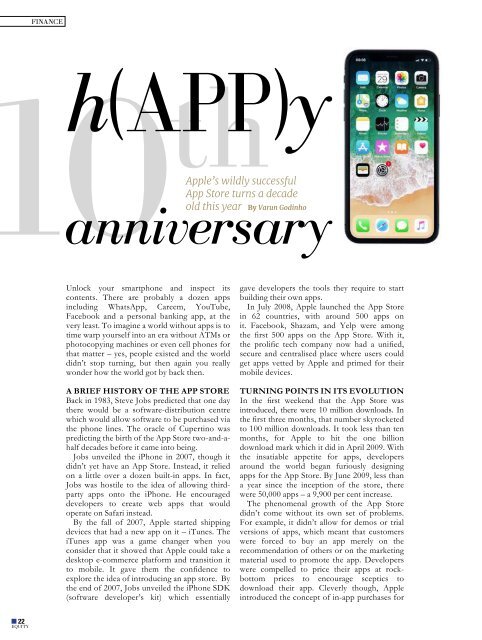Create successful ePaper yourself
Turn your PDF publications into a flip-book with our unique Google optimized e-Paper software.
FINANCE<br />
0 th<br />
Apple’s wildly successful<br />
App Store turns a decade<br />
old this year By Varun Godinho<br />
h(APP)y<br />
anniversary<br />
Unlock your smartphone and inspect its<br />
contents. There are probably a dozen apps<br />
including WhatsApp, Careem, YouTube,<br />
Facebook and a personal banking app, at the<br />
very least. To imagine a world without apps is to<br />
time warp yourself into an era without ATMs or<br />
photocopying machines or even cell phones for<br />
that matter – yes, people existed and the world<br />
didn’t stop turning, but then again you really<br />
wonder how the world got by back then.<br />
A BRIEF HISTORY OF THE APP STORE<br />
Back in 1983, Steve Jobs predicted that one day<br />
there would be a software-distribution centre<br />
which would allow software to be purchased via<br />
the phone lines. The oracle of Cupertino was<br />
predicting the birth of the App Store two-and-ahalf<br />
decades before it came into being.<br />
Jobs unveiled the iPhone in 2007, though it<br />
didn’t yet have an App Store. Instead, it relied<br />
on a little over a dozen built-in apps. In fact,<br />
Jobs was hostile to the idea of allowing thirdparty<br />
apps onto the iPhone. He encouraged<br />
developers to create web apps that would<br />
operate on Safari instead.<br />
By the fall of 2007, Apple started shipping<br />
devices that had a new app on it – iTunes. The<br />
iTunes app was a game changer when you<br />
consider that it showed that Apple could take a<br />
desktop e-commerce platform and transition it<br />
to mobile. It gave them the confidence to<br />
explore the idea of introducing an app store. By<br />
the end of 2007, Jobs unveiled the iPhone SDK<br />
(software developer’s kit) which essentially<br />
gave developers the tools they require to start<br />
building their own apps.<br />
In July 2008, Apple launched the App Store<br />
in 62 countries, with around 500 apps on<br />
it. Facebook, Shazam, and Yelp were among<br />
the first 500 apps on the App Store. With it,<br />
the prolific tech company now had a unified,<br />
secure and centralised place where users could<br />
get apps vetted by Apple and primed for their<br />
mobile devices.<br />
TURNING POINTS IN ITS EVOLUTION<br />
In the first weekend that the App Store was<br />
introduced, there were 10 million downloads. In<br />
the first three months, that number skyrocketed<br />
to 100 million downloads. It took less than ten<br />
months, for Apple to hit the one billion<br />
download mark which it did in <strong>April</strong> 2009. With<br />
the insatiable appetite for apps, developers<br />
around the world began furiously designing<br />
apps for the App Store. By June 2009, less than<br />
a year since the inception of the store, there<br />
were 50,000 apps – a 9,900 per cent increase.<br />
The phenomenal growth of the App Store<br />
didn’t come without its own set of problems.<br />
For example, it didn’t allow for demos or trial<br />
versions of apps, which meant that customers<br />
were forced to buy an app merely on the<br />
recommendation of others or on the marketing<br />
material used to promote the app. Developers<br />
were compelled to price their apps at rockbottom<br />
prices to encourage sceptics to<br />
download their app. Cleverly though, Apple<br />
introduced the concept of in-app purchases for<br />
22<br />
EQUITY
















